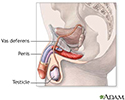Penile cancer
Cancer - penis; Squamous cell cancer - penis; Glansectomy; Partial penectomyPenile cancer is cancer that starts in the penis, an organ that makes up part of the male reproductive system.
Cancer
Cancer is the uncontrolled growth of abnormal cells in the body. Cancerous cells are also called malignant cells.

Penis
The penis is the male organ used for urination and sexual intercourse. The penis is located above the scrotum. It is made of spongy tissue and bloo...

Causes
Cancer of the penis is rare. Its exact cause is unknown. However, certain risk factors include:
- Uncircumcised men who don't keep the area under the foreskin clean. This leads to buildup of smegma, a cheese-like, foul-smelling substance under the foreskin.
- History of genital warts, or human papillomavirus (HPV).
Genital warts
Genital warts are soft growths on the skin and mucous membranes of the genitals. They may be found on the penis, vulva, urethra, vagina, cervix, and...
 ImageRead Article Now Book Mark Article
ImageRead Article Now Book Mark Article - Smoking.
- Injury to the penis.
The cancer usually affects middle age and older men.
Symptoms
Early symptoms may include:
- Sore, bump, rash, or swelling at the tip or on the shaft of the penis
- Foul-smelling discharge beneath the foreskin
As the cancer advances, symptoms may include:
- Pain and bleeding from the penis (may occur with advanced disease)
- Lumps in the groin area from spread of the cancer to the groin lymph nodes
- Weight loss
- Difficulty in passing urine
Exams and Tests
Your health care provider will perform a physical exam and ask about your health history and symptoms.
A biopsy of the growth is needed to determine if it is cancer.
Biopsy
A biopsy is the removal of a small piece of tissue for lab examination.

Treatment
Treatment depends on the size and location of the tumor and how much it has spread.
Treatment for penile cancer may include:
-
Chemotherapy -- uses medicines to kill cancer cells
Chemotherapy
The term chemotherapy is used to describe cancer-killing drugs. Chemotherapy may be used to:Cure the cancerShrink the cancerPrevent the cancer from ...
 ImageRead Article Now Book Mark Article
ImageRead Article Now Book Mark Article -
Radiation -- uses high-powered x-rays to kill cancer cells
Radiation
Radiation therapy uses high-powered radiation (such as x-rays or gamma rays), particles, or radioactive seeds to kill cancer cells.
 ImageRead Article Now Book Mark Article
ImageRead Article Now Book Mark Article - Surgery - cuts out and removes the cancer
If the tumor is small or near the tip of the penis, surgery may be done to remove only the cancerous part of the penis where the cancer is found. Depending on the exact location, this is called a glansectomy or partial penectomy. Laser surgery may be used to treat some tumors.
For more severe tumors, total removal of the penis (total penectomy) is often needed. A new opening will be created in the groin area to allow urine to exit the body. This procedure is called a urethrostomy.
Chemotherapy may be used along with surgery.
Radiation therapy may be used along with surgery. A type of radiation therapy called external beam therapy is often used. This method delivers radiation to the penis from outside the body. This therapy is most often performed 5 days a week for 6 to 8 weeks.
Outlook (Prognosis)
The outcome can be good with early diagnosis and treatment. Urination and sexual function can often be maintained.
Possible Complications
Untreated, penile cancer can spread to other parts of the body (metastasize) early in the disease.
Metastasize
Metastasis is the movement or spreading of cancer cells from one organ or tissue to another. Cancer cells usually spread through the blood or the ly...

When to Contact a Medical Professional
Contact your provider if symptoms of penile cancer develop.
Prevention
Penile cancer is very rare. Circumcision may decrease the risk of penile cancer and of developing penile cancer due to HPV infection. HPV vaccination for children and young adults can also lower the risk of developing cancer due to HPV infection in adulthood.
Men who are not circumcised should be taught at an early age the importance of cleaning beneath the foreskin as part of their personal hygiene.
Safer sexual practices, such as limiting the number of sexual partners, and using condoms to prevent HPV infection, may decrease the risk of developing cancer of the penis.
References
Heinlen JE, Ramadan MO, Stratton K, Culkin DJ. Cancer of the penis. In: Niederhuber JE, Armitage JO, Kastan MB, Doroshow JH, Tepper JE, eds. Abeloff's Clinical Oncology. 6th ed. Philadelphia, PA: Elsevier; 2020:chap 82.
National Cancer Institute website. Penile cancer treatment (PDQ) - health professional version. www.cancer.gov/types/penile/hp/penile-treatment-pdq#link/_1. Updated February 2, 2024. Accessed August 2, 2024.
-
Male reproductive anatomy - illustration
The male reproductive structures include the penis, the scrotum, the testicles (testes), the epididymis, the seminal vesicles, and the prostate.
Male reproductive anatomy
illustration
-
Male reproductive system - illustration
The male reproductive structures include the penis, the scrotum, the testicles (testes), the epididymis, the seminal vesicles, and the prostate.
Male reproductive system
illustration
-
Male reproductive anatomy - illustration
The male reproductive structures include the penis, the scrotum, the testicles (testes), the epididymis, the seminal vesicles, and the prostate.
Male reproductive anatomy
illustration
-
Male reproductive system - illustration
The male reproductive structures include the penis, the scrotum, the testicles (testes), the epididymis, the seminal vesicles, and the prostate.
Male reproductive system
illustration
Review Date: 7/29/2024
Reviewed By: Warren Brenner, MD, Oncologist, Lynn Cancer Institute, Boca Raton, FL. Review provided by VeriMed Healthcare Network. Also reviewed by David C. Dugdale, MD, Medical Director, Brenda Conaway, Editorial Director, and the A.D.A.M. Editorial team.



